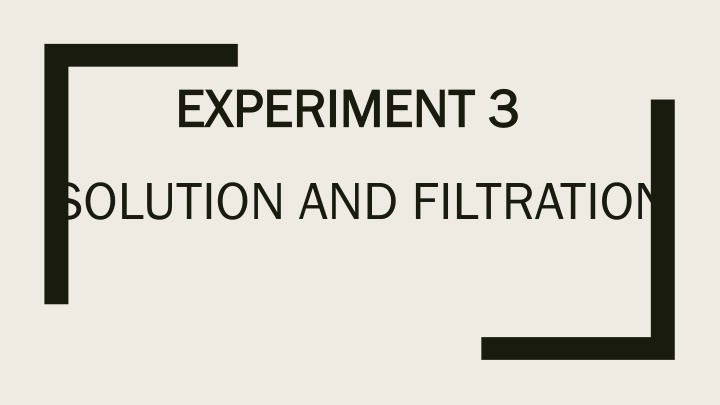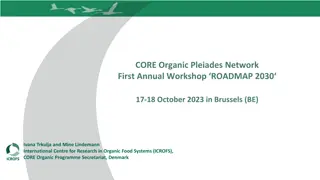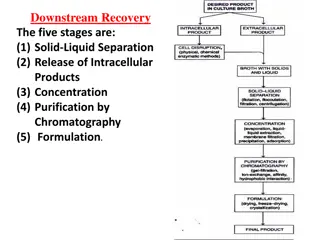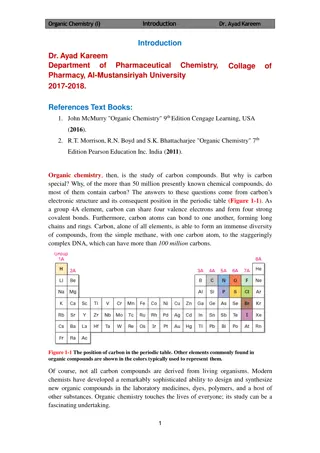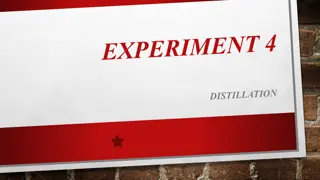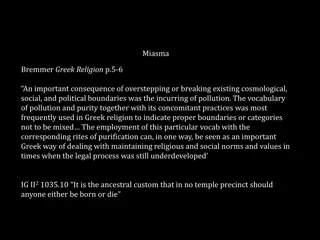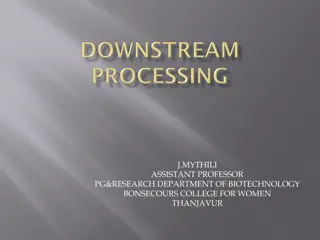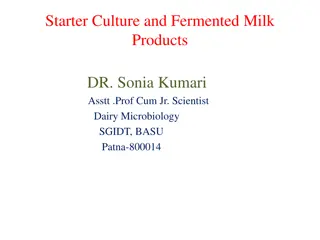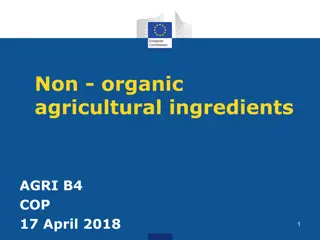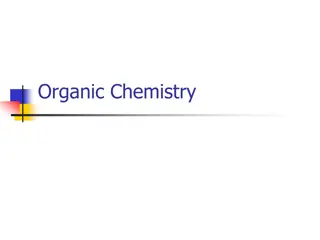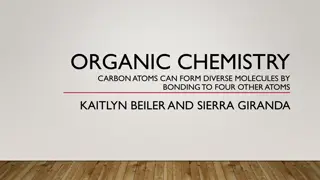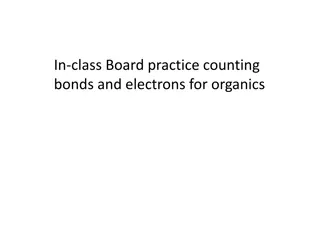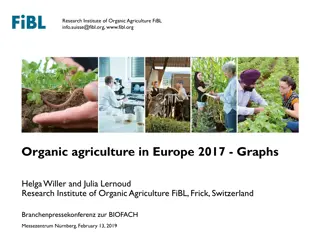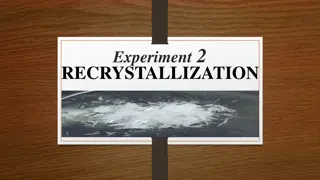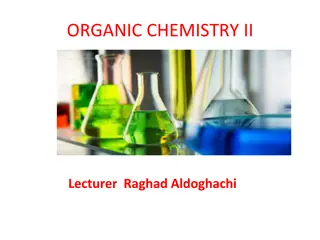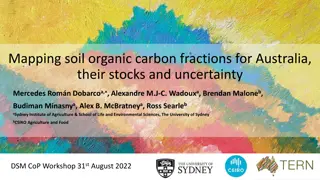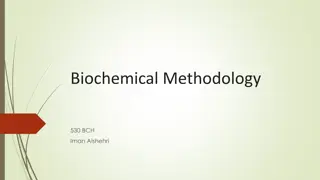Separation and Purification of Organic Compounds: Methods and Techniques
The separation and purification of organic compounds are essential processes to obtain pure products, as impurities and side reactions can affect the quality of the compounds. Methods such as solution and filtration, crystallization, distillation, extraction, sublimation, and chromatography are commonly used in organic chemistry laboratories. Filtration is a crucial technique to remove solid impurities or isolate organic solids from solutions. Solubility plays a key role in these processes, with different types determining the suitability of compounds for various reactions and purification methods.
Download Presentation

Please find below an Image/Link to download the presentation.
The content on the website is provided AS IS for your information and personal use only. It may not be sold, licensed, or shared on other websites without obtaining consent from the author.If you encounter any issues during the download, it is possible that the publisher has removed the file from their server.
You are allowed to download the files provided on this website for personal or commercial use, subject to the condition that they are used lawfully. All files are the property of their respective owners.
The content on the website is provided AS IS for your information and personal use only. It may not be sold, licensed, or shared on other websites without obtaining consent from the author.
E N D
Presentation Transcript
EXPERIMENT EXPERIMENT 3 3 SOLUTION AND FILTRATION
SEPARATION AND PURIFICATION OF SEPARATION AND PURIFICATION OF ORGANIC COMPOUNDS ORGANIC COMPOUNDS The separation and purification of organic compounds is important way to get pure organic compounds. Products of organic reactions are seldom pure products as a result of side reactions. Pure compounds are also subject to partial decomposition on standing for some time or on exposure to light, air, heat, moisture, etc. (for example acetyl salicylic acid, commonly called aspirin, decomposes to salicylic acid). Therefore, the process of separation and purification of organic compounds becomes an important technique to get pure compounds.
Generally, organic compounds are separated and purified by the following methods: 1- Solution and filtration. 2- Crystallization. 3- Distillation. 4- Extraction. 5- Sublimation. 6- Chromatographic methods as TLC, GC.
When a solid or a liquid* (solutes can be solids or liquids, while solvents are liquids) dissolves, the structural units ions or molecules, become separated from each other and the solvent molecules occupy the space between them. Filtration is a technique used either to remove solid impurities from an organic solution or to isolate an organic solid. The two types of filtration commonly used in organic chemistry laboratories are gravity filtration and vacuum or suction filtration.
The solubility of organic compounds can be divided into two major types; 1- Solubility in which the chemical reaction is the driving forces, for example, acid-base reactions: Benzoic acid Sodium benzoate (Water insoluble) (Water soluble)
2- Solubility in which only simple miscibility is involved, for example, ethyl ether in carbon tetrachloride. The first type is used to identify the functional groups involved in the compound, while the second type is used to determine solvents for recrystallization and chemical reactions. The filtration is an important procedure after completing the reaction either to separate the solid product (precipitate) or to get rid of insoluble impurities or reactant materials. The desired soluble compound is recovered from the filtrate by evaporating the solvent.
The liquid is poured into a filter paper fitted in a funnel and either the precipitate is collected or the filtrate that contains the desired soluble compound is collected. In this method we take the advantage that one compound in the mixture is readily soluble in a given solvent whereas the remainder of the mixture may be relatively insoluble.
Filtering Techniques: 1- Gravity Filtration: Gravity filtration is the method of choice to remove solid impurities from an organic liquid. The impurity can be a drying agent or an undesired side product or leftover reactant. Gravity filtration can be used to collect solid product, although generally vacuum filtration is used for this purpose because it is faster. A filtration procedure called "hot gravity filtration" is used to separate insoluble impurities from a hot solution.
Flute filter paper. Fluting is desirable when a rapid filtration is necessary, as in the filtration of the hot solution during a recrystallization. Fig. Fig.12 12: Fluting a filter paper (paper folded with many pleats to give a large surface) : Fluting a filter paper (paper folded with many pleats to give a large surface)
Place filter paper in the funnel. Place the funnel either directly on top of the beaker or on a ring stand above the beaker (see Fig. 4 below). Fig. Fig.4 4. A beaker containing a stem less funnel. Note that the filter paper is fluted; however, that is not . A beaker containing a stem less funnel. Note that the filter paper is fluted; however, that is not necessary for all applications. necessary for all applications.
Wet the filter paper using a small amount of the liquid that is the solvent of the mixture being filtered. After the filtrate has been collected, pass a small amount of the wash liquid through the filter paper to wash the residue.
2- Vacuum Filtration with Buchner funnel: Vacuum filtration is used primarily to collect a desired solid, for instance, the collection of crystals in a recrystallization procedure. Vacuum filtration uses a Buchner funnel and a side-arm flask. Vacuum filtration is faster than gravity filtration, because the solvent or solution and air is forced through the filter paper by the application of reduced pressure. Do not use vacuum filtration to filter a solid from a liquid if it is the liquid that you want, and if the liquid is low boiling. Any solvent which boils at about 125 degrees or lower will boil off under the reduced pressure in the vacuum flask.
Select a Buchner funnel of appropriate size for the amount of residue you are collecting, not the amount of filtrate. Put a piece of filter paper in the funnel that fits exactly and wet the paper using a small amount of solvent. Place the funnel in a filter flask and connect the rubber tubing (see Fig. 4 below). Fig. Fig. 14 14. A Buchner funnel in a filter flask, with rubber tubing connected to an . A Buchner funnel in a filter flask, with rubber tubing connected to an aspirator. aspirator.
Using rubber tubing, the filter flask is connected to a trap, which in turn is connected to an aspirator, which provides the vacuum. Pour 15 ml of solvent through the funnel to wet the filter paper. Discard this water. Reconnect the flask to the aspirator. After the filtrate has been collected, pass a small amount of pure solvent through the filter to wash the residue.
3- Vacuum Filtration with Filter Crucible: To use a filter crucible, set up vacuum filtration by placing the filter crucible in a holder and placing that in a filter flask (see Fig. 3 below). Fig. Fig. 15 15. A filter crucible in a crucible holder in a filter flask, with rubber tubing connected to an . A filter crucible in a crucible holder in a filter flask, with rubber tubing connected to an aspirator aspirator
